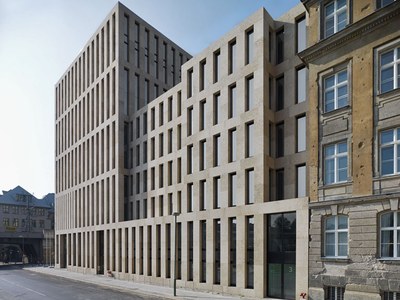City Spatial environment

Exterior view from the direction of the Geschwister-Scholl-Straße [© fotographer Stefan Müller]
The plot of the Jacob-und-Wilhelm-Grimm-Zentrum is located north of the rail viaduct between the Planckstrasse to the west and the Geschwister-Scholl-Strasse in the east. After North the Jacob-und-Wilhelm-Grimm-Zentrum includes the existing building. From the east there will be further developed in future by the planned promenade in the museum courtyards (former Friedrich Engels Barracks), which establishes a connection between urban Spandauer Vorstadt (Monbijou on the bridge), Museum Island, and Dorothy city. This walk is through the southern forecourt outside the main entrance towards the continued Friedrichstrasse Station. There is a good connection to public transport and regional services of the railway.
The environment is characterized by a high density of buildings for science (the main building and institutes of the Humboldt Universität zu Berlin, Staatsbibliothek zu Berlin, Berlin-Brandenburgische Akademie der Wissenschaften) and culture (German Historical Museum, National Museums in Berlin, the German State Opera House, Gorky Theatre and Admiral Palace ) out. The close proximity of University College, State Library and State Museum has grown historically and in the past belonged to the core of the self-image of Berlin as a location for science and culture.
The planned development of the Palace Square with the Humboldt-Forum would round out this ensemble to the southeast. Even today the area is west of the River Spree to the Brandenburg Gate with the Staatsbibliothek zu Berlin, the Central and Regional Library, the University Library of Humboldt Universität zu Berlin, with its branches and other libraries of different institutions a dense library landscape with over 15 million items.
Historically the land belongs to Dorotheenstadt or New Town, a planned urban extension of the 17 Century to 1710 ordered the city via its own right, until it was merged with Berlin, Cologne and other urban sprawl. Dorotheenstadt for the whole area is one of the moat in the east to the Brandenburg Gate in the west and the River Spree in the north to the south Behrenstraße. Later, there were also some enhancements.
With the establishment of the academy, the Royal Library, the State Opera and in 1810 the Humboldt Universität zu Berlin began to develop a location for science and culture. In the late 18th Century, used the land between George Street and Spree as building market. East was by this time the barracks. In the first half of the 19th Century were built on the land then. At the same time began the building of the Museum Island, which was only completed in 1930 with the Pergamon Museum. Already in 1882 the railway line was taken on the rail viaduct to operate.
The opening of the new building of the Royal Library, Unter den Linden (now the State Library) 1914 and the extensions of the main building of Humboldt Universität in 1920 constituted further steps for modeling the urban area escalation of the destruction of the second World War II had affected much of the next Dorotheenstadt the development of the land, the below only as a storage area and gas station - was used in the South as a street railway. In contrast, the buildings were the barracks in the north and largely preserved.
The resulting construction of the Jacob-und-Wilhelm-Grimm-Zentrum closes the existing gap, the extended band of culture and science in the direction of the Friedrichstrasse station, creating another center for the University area north of the city center railway viaduct.
